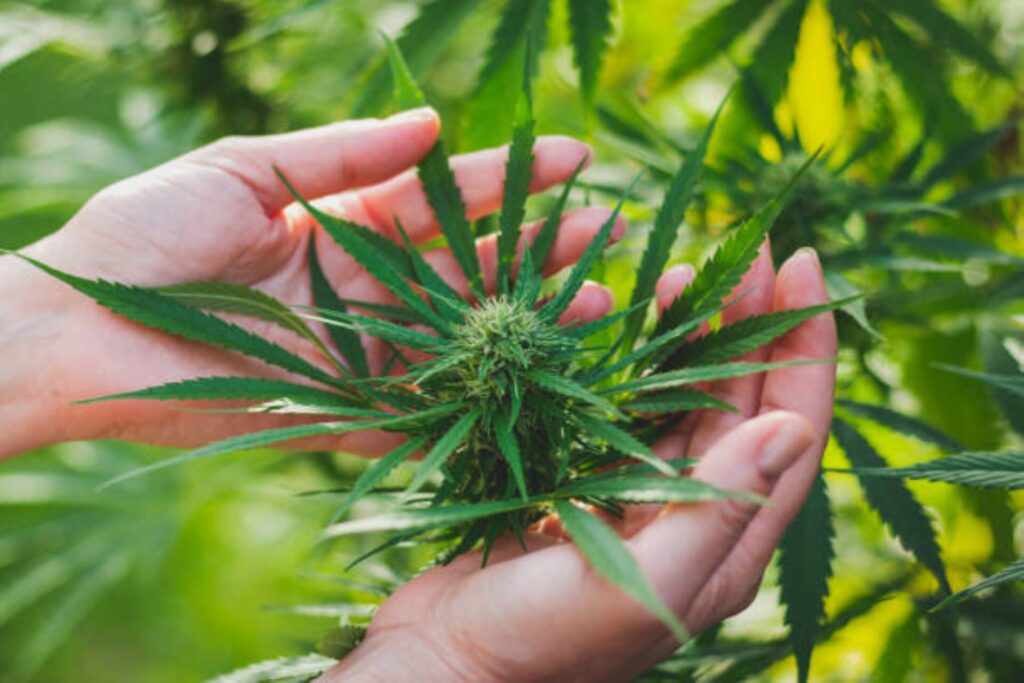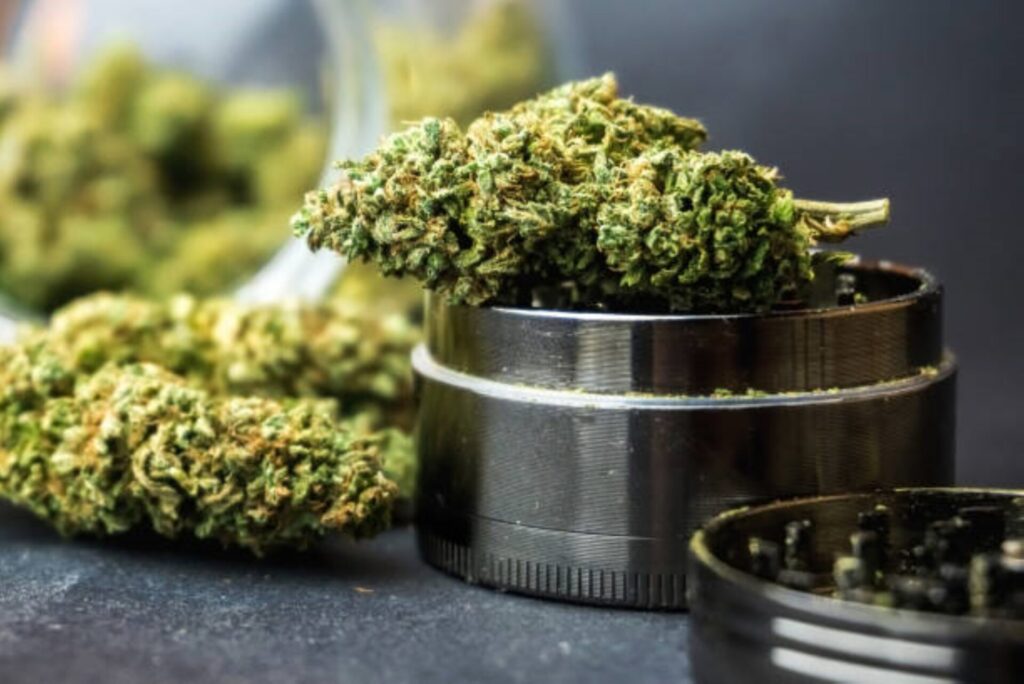At Pure Blue Cannabis, we are dedicated to producing top tier cannabis products by meticulously managing each stage of the cannabis growth process. Our journey begins with the selection of premium cannabis seeds, which we carefully nurture through various growth stages, prioritizing excellence and sustainability. Our team of expert cannabis cultivators employs advanced techniques to optimize plant development, ensuring our cannabis plants thrive in both indoor and outdoor environments.
This article explores the intricate cannabis growth process, detailing each stage from germination to harvest. Our comprehensive guide highlights the crucial factors influencing cannabis plant development, such as environmental conditions, nutrient requirements, and cultivation practices. Continue reading to uncover the complexities of each phase, from choosing the right cannabis seeds to achieving a successful harvest.
Key takeaways
- The cannabis growth cycle typically lasts 4 to 8 months, with indoor environments allowing for significantly faster flowering compared to outdoor conditions.
- Successful germination relies on maintaining optimal moisture, temperature, and humidity levels, which are essential for seed development.
- The flowering stage is crucial for bud development, requiring careful nutrient management and environmental control to maximize yield and potency.
Germination: The first step
Germination is the initial and crucial step in the cannabis growth process. During this stage, the cannabis seed awakens from dormancy and begins to sprout. Optimal moisture levels are necessary for successful germination, needing complete saturation at the start to activate the seed. Temperature also plays a significant role, with ideal germination temperatures starting around 85°F and then reducing to between 75°F and 78°F.
Moisture significantly impacts cannabis seed germination, influencing the seed’s ability to sprout. This process sets the foundation for the plant’s future development, so it is vital to do it correctly.
In the following subsections, we’ll explore the ideal conditions for germinating seeds and some common germination methods that our growers use to ensure successful marijuana plant development.
Ideal conditions for germinating seeds
Ensuring the right humidity levels and darkness is essential for the germination of cannabis seeds. Humidity should ideally be between 60% and 75% to prevent disease and promote healthy sprouting. Cannabis seeds thrive best in dark conditions, which support successful germination.
By maintaining these conditions, cannabis seeds are given the best opportunity to sprout and develop into healthy seedlings. Creating an ideal environment for germination is the first step toward successful cannabis cultivation.

Seedling stage: Early development
Once the cannabis seeds have successfully germinated, they enter the seedling stage. During this early development phase, seedlings generally grow a few inches tall and develop their first true leaves, which are essential for photosynthesis. The typical length of the seedling stage is between 2 to 3 weeks, a critical period for establishing initial growth.
Healthy seedlings display characteristics such as vibrant green leaves and a short, squat appearance. Proper care during this stage helps the root system establish itself, supporting the plant’s overall health and stability.
In the following subsections, we’ll delve into caring for young plants and the process of transplanting seedlings.
Caring for young plants
Young cannabis plants require precise amounts of water and nutrients without excess. Seedlings require significantly less water compared to later growth stages, and overwatering can be detrimental. Lighting is also crucial, with PPFD levels of 200-400 being adequate for cannabis seedlings.
Keeping humidity levels between 60% to 75% and ensuring clean conditions helps prevent diseases and mold. Seedlings should only be moved outdoors once they are stable enough to handle the conditions, ensuring their continued healthy development.
Transplanting seedlings
Transplanting seedlings is a crucial step in the cannabis growth process. Once cannabis seeds are planted in soil, they should remain in place until the roots are firmly established.
For autoflowering seedlings, transplanting them directly into their final containers can improve growth efficiency.
Vegetative stage: Robust growth
The vegetative stage is when cannabis plants focus on developing their root system, stem structure, and leaves for photosynthesis. This stage is crucial. It lays the strong foundation needed for the flowering phase. During this period, roots grow downwards while the stem extends upwards. Plants should be placed in larger pots to support rapid bud growth.
Indoor cannabis plants typically require 18-24 hours of light daily during the vegetative stage, with full-spectrum LED lights being ideal for promoting vigorous growth. Outdoor plants, on the other hand, should receive full, direct sun for at least 6 hours a day.
Nutrient needs in the vegetative phase
During the vegetative phase, cannabis plants require increased nitrogen, which supports leaf and stem development. High levels of nitrogen-rich nutrients should be provided to ensure healthy growth. As the plant develops, watering should be increased to match nutrient absorption needs.
However, it’s essential to manage nutrients carefully, as excessive nutrients can burn the plant. No grow nutrients are needed until a week after the first set of leaves emerges. Balancing light, water, and nutrients specific to each growth stage ensures optimal plant development.
Training techniques for optimal yield
Training techniques such as topping and low-stress training (LST) can significantly enhance cannabis yield by promoting a healthy plant structure. Topping helps develop multiple main branches, leading to increased bud sites and higher yields. LST involves gently bending branches to improve light exposure and enhance growth.

Pre-flowering: Transition phase
The pre-flowering stage marks the transition from vegetative growth to the flowering phase. This transition is signaled by the development of pre-flowers, which are the starting formation of the plant’s sex organs. Autoflower cannabis plants transition to flowering differently, starting the process as soon as they are ready without holding back.
In this phase, it’s crucial to identify male and female plants to prevent pollination and ensure a high-quality yield. Preparing for the flowering stage involves making adjustments to the light cycle and nutrients.
The following subsections will provide more details on identifying plant sex and preparing for the flowering stage.
Identifying male and female plants
Identifying the sex of cannabis plants early in the flowering stage is critical for a successful cannabis cultivation process. Male plants produce round pollen sacs, while female plants develop noticeable white hairs known as stigmas during the pre-flowering stage.
Separating male and female cannabis plants prevents pollination, maximizing bud production. Pre-flowers are indicators seen at nodes between the stem and branches that inform about the plant’s sex. This step ensures only female plants produce cannabis buds, leading to a higher quality harvest.
Preparing for flowering
Preparing for the flowering stage involves modifying the light cycle and adjusting nutrient intake. Cannabis plants typically enter the blooming phase as daylight hours decrease, often around August in the Northern Hemisphere.
Nutritional changes are necessary, shifting towards higher phosphorus and potassium levels to support bud development. Outdoor cannabis plants’ blooming period can be influenced by factors such as greenhouse blackout blinds and variations in daylight hours.
Getting plants ready for the flowering phase is crucial for achieving a successful yield
Flowering stage: Bud development
The flowering stage is a pivotal phase in the cannabis growth cycle, crucial for determining the quality and quantity of the harvest. Typically, most cannabis strains undergo this stage for about 7 to 9 weeks, initiated by reducing light exposure to 12 hours per day. Outdoors, flowering naturally occurs as light conditions transition from summer to fall. During this time, cannabis plants necessitate a shift in nutrients, with increased phosphorus and potassium being vital for bud formation.
As the flowering stage advances, cannabis plants can expand to 2-3 times their height from the end of the vegetative stage. Healthy plants in this phase showcase light green foliage where buds develop, alongside noticeable stretching. The flowering stages of cannabis growth can be categorized into early bloom, mid-bloom, and late bloom phases, each demanding careful management to ensure optimal bud.
Understanding the life cycle of cannabis plants
Knowing the cannabis life cycle is vital for successful cultivation. The cannabis growth stages include germination, seedling, vegetative, pre-flowering, flowering, and harvesting. Growing cannabis from seed to harvest can take approximately 3-8 months, depending on various factors such as strain genetics, growing environment, and grower interventions.
Outdoor seed varieties typically have a life cycle of up to 6 months and are annuals, living for one season growing outdoors. Factors influencing the cannabis growth timeline include environmental conditions and specific phenotypes.
Differences between Indica and Sativa growth cycles
Indica and Sativa cannabis plants exhibit distinct growth cycles. Indica plants typically complete their flowering stage earlier, while Sativas have an extended growth period and finish flowering later.
These variations necessitate different cultivation approaches. Indicas, being more compact and bushy, are often ideal for indoor cultivation. Conversely, Sativas, with their taller stature, are better suited for outdoor growing conditions.
Maintaining a consistent growth environment
Maintaining a stable growth environment is crucial for cultivating healthy and productive cannabis plants. Ensuring cleanliness is vital to prevent diseases and mold. Additionally, keeping an eye on moisture levels within the growing environment helps avert mold and other diseases that could harm seedlings.
At Pure Blue Cannabis, we are committed to cultivating cannabis of the highest quality. Our dedication to excellence goes beyond cultivation; we implement stringent quality control measures throughout the entire cannabis growth process. From selecting top-tier cannabis seeds to employing advanced cultivation techniques, our focus is on nurturing strong cannabis plants under optimal environmental conditions.
Our cannabis cultivators are devoted to understanding each plant’s unique requirements, ensuring meticulous management at every stage of growth, from seedling to flowering. We emphasize sustainability and innovation, aiming to produce cannabis that not only meets but surpasses cannabis industry standards, delivering exceptional products to our valued customers.
Summary
The cannabis growth process is a detailed and intricate journey that begins with the careful selection of high quality cannabis seeds and progresses through a series of distinct growth stages, each with its specific requirements. From the initial germination to the final harvest, understanding the complexities of each phase is crucial for successful cannabis cultivation.
At Pure Blue Cannabis, we are committed to delivering premium cannabis products by meticulously overseeing every stage of the cannabis growth process. By selecting the highest quality cannabis seeds and utilizing cutting-edge cultivation techniques, we ensure our cannabis plants are nurtured under ideal conditions to thrive. Contact us today and explore the vast potential of cannabis cultivation with our expert guidance and premium products!

Frequently asked questions
How many weeks should a cannabis plant be in the veg?
A cannabis plant should typically remain in the vegetative stage for 4 to 8 weeks, with pre-flowers usually appearing around 4 to 6 weeks.
How long does it take to grow cannabis from seed to harvest?
It typically takes between 4 to 8 months to grow cannabis from seed to harvest, varying based on the strain and growing conditions.
What are the ideal conditions for germinating cannabis seeds?
For successful cannabis seed germination, maintain humidity levels between 60% and 75%, and ensure the seeds are kept in dark conditions. These factors create the optimal environment for growth.

